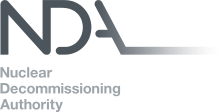Nuclear Decommissioning Authority
|
|
Bespoke equipment reveals beneath Dounreay reactor top
The removal of trapped fuel elements from the Dounreay Fast Reactor moved a step closer with the successful trial of bespoke equipment to lift off the top plate.
Decommissioning the 50-year-old experimental reactor is one of the most technically challenging projects in the NDA estate.
In 2012, a camera looked inside the reactor for the first time. Subsequent inspections over a three-month period enabled the Dounreay Fast Reactor (DFR) team to assess the internal conditions in detail, providing an accurate basis for planning future fuel removal.
The reactor top plate, a stainless steel honeycomb structure, has been submerged in hazardous radioactive alkali metal for decades.
Working with Caithness company Enterprise Engineering Services Ltd, the DFR team has now carried out a series of trials, using specialised equipment to demonstrate that sections of the reactor top plate can be removed to release the trapped elements underneath.
The equipment was manufactured and trialled extensively at the company’s off-site facility, before installation works on the reactor top were completed successfully and on schedule.
Additional work is planned during the summer to prepare for removal and repackaging of the remaining fuel.
Andy Beckwith, project director for fuels, said:
“DFR decommissioning is one of the most technically challenging projects for the NDA estate and the safe removal of the breeder fuel elements is crucial to the site’s closure programme.
“This project proves that with a dedicated and committed team of people all working together these challenges can be achieved safely, allowing future DFR decommissioning projects to progress.”
Meanwhile, 5 tonnes of cables connected to the hub that once controlled the reactor have been ripped out.
Large quantities of mineral-insulated copper conductors were used because of their resistance to heat and overall strength even when flattened.
The cables fed into equipment used for reactor control, temperature monitoring, trace heating systems and distribution boards. Their removal will allow the DFR decommissioning team to clear old distribution boards and cables from areas next to the reactor floor, in turn making space for the removal of other fixtures and fittings. The work is due to be complete by June.
Project Manager, Suzanne Griffiths, said:
“We have now removed approximately five tonnes of cabling and junction boxes from the sphere skirt and underground duct, which has presented many challenges including the safe removal of asbestos.”
Fact File
- Dounreay’s experimental fast breeder reactor, housed inside a steel sphere, led British nuclear R&D during the 1950s and 60s.
- Built in the 1950s, the DFR became the world’s first fast reactor to provide electricity to a national grid in 1962. Its 14MW output was enough to power a small town like Thurso (population of approx 9,000). It closed in 1977.
- The reactor was one of only two ever built in the UK to run on liquid metal – an alloy of sodium and potassium known as NaK.
- Following closure, the reactor was defuelled, the liquid metal removed from the secondary circuit and some of the breeder material taken out.
- Construction started in 2003 on the plant needed to remove the rest of the breeder material and destruction of the bulk liquid metal in the primary cooling circuit was completed in 2012.
- Once the residues of liquid metal have been cleansed from the circuits and all the nuclear material removed, work will begin to dismantle the reactor structure, including the sphere.
|
|
||||||||||||||




.gif)